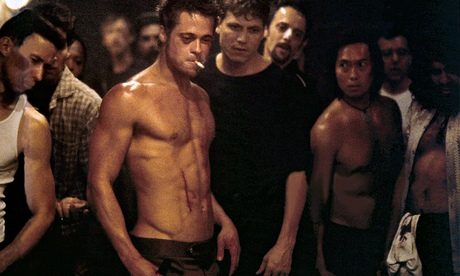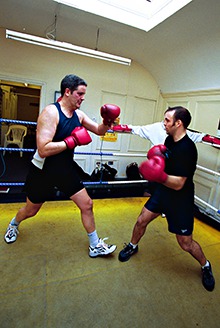
‘The 1999 movie Fight Club, with its portrait of emasculated males hunting for an outlet for their baser instincts, acted as a recruiting sergeant for gyms that presented white-collar boxing.’ Photograph: Allstar/Cinetext/20th Century Fox
When it came to white-collar boxing I was an early adopter. In 2000, I was carrying out a fitness programme and started out going to former European featherweight champion Jim McDonnell’s health club in Camden, north London. I was 43 many years outdated, 3 stone obese and immediately hooked. Working out in a gym with a ring is a thousand times more entertaining than paying countless time on a treadmill or workout bike. The boxing gave the slog a level.
On the wall of McDonnell’s health club was a poster recruiting would-be white-collar boxers for a fight evening at Gleason’s gymnasium in New York – a bunch of British boxers pitted against the may possibly of the US. Well, when I say the may, most of them have been blokes like me – sedentary middle-aged men seeking to get a bit fitter. They worked out at Gleason’s in Brooklyn routinely and as soon as a month gathered for a appropriate battle – three two-minute rounds in a ring, watched by 50 or so buddies and fellow fighters.
 Stephen Moss (left), back in his boxing days. Photograph: Frank Baron for the Guardian
Stephen Moss (left), back in his boxing days. Photograph: Frank Baron for the Guardian
I was put in with a 58-year-previous who had taken up boxing following suffering a heart attack. He determined he essential to shed some bodyweight, and boxing appeared the ideal way to do it. It is the most fantastic physical exercise: substantial intensity, all the limbs are moving concurrently, and you have to try out to hold the brain fully centered.
We invested six minutes moving round the ring and failing to land any punches in what may possibly have been the most dull “battle” of all time. A girl from Channel four, who was there recce-ing white collar boxing for a attainable documentary, described it as a “gentlemen’s fight” – minimal speak to, no blood – which was just the way I liked it. I had been terrified ahead of my physical appearance afterwards, I felt wonderful. At Gleason’s everybody was declared a winner – the actual challenge was just to climb via the ropes – and all the participants have been handed a rather naff plastic trophy. Americans adore trophies.
White-collar boxing subsequently grew to become large enterprise, with plenty of gyms opening up to cater for blokes who wanted an adrenaline-fuelled way to get match. The 1999 movie Fight Club, with its portrait of emasculated males searching for an outlet for their baser instincts, acted as a recruiting sergeant for gyms that supplied white-collar boxing. I keep in mind seeing the movie and strolling on air as I emerged in Leicester Square, recklessly crossing roads as if no auto could harm me. It is that sort of film – an ode to liberation.
Now white-collar boxing, which has usually had its critics, faces a crisis. A 32-yr-old, Lance Ferguson-Prayogg, has died following a white-collar battle in Nottingham. The trigger of his death has nevertheless to be confirmed, but already there are calls for this kind of boxing to be created unlawful. This branch of the “sport” has, in fact, often existed in a sort of legal limbo, and it is by no means clear whether or not boxing of this kind – occasions amongst unlicensed boxers for which tickets have been offered – was ever really legal.
I have watched one particular of Ferguson-Prayogg’s fights on-line, and it bears no resemblance to the type of white-collar boxing I did in the United kingdom or at Gleason’s. My boxing was a kind of enhanced kind of sparring – constantly wearing headguards and with no winner declared, although some of the boxers I fought alongside at Gleason’s were taking it a good deal far more seriously than me, and there were knockdowns.
Ferguson-Prayogg’s fights had been complete-on battles – no headguards, in effect pro boxing but with much less technique. Some of the knockdowns are brutal. The fights were refereed, medical personnel have been present, a entire body named the Organised Global Boxing Association supervised Ferguson-Prayogg’s fatal battle, and it claims absolutely everyone who fights below its auspices has a complete healthcare. That is clearly better than completely unsupervised boxing – blokes bashing the hell out of every single other in a basement, Fight Club-type – but it is nonetheless highly questionable.
The British Boxing Board of Handle, which oversees skilled boxing in the Uk, has manufactured its emotions plain. “We have totally nothing to do with the OIBA and do not condone what they do,” a spokesman mentioned. “Our body regulates skilled boxing to a strict set of guidelines and rules. Boxing can be an extremely harmful sport and we have strict medical procedures to comply with in all professional bouts.”
They are obviously proper. The type of fight Ferguson-Prayogg, a supremely fit youthful guy who boxed a lot, engaged in needs to be licensed either by the expert game, or under amateur principles (overseen by the British Amateur Boxing Association) with strict medicals, headguards, principles on the number of head punches and interventionist refereeing. A single difficulty is that amateur clubs can be tough to discover or open at inconvenient hrs, which is why some young professionals are ready to spend a great deal of money for the white-collar knowledge.
Really the place that leaves the sort of pseudo-battle I had at Gleason’s I am not sure. Drawing the line between a full-on battle and what is in result a kind of advanced form of boxercise is constantly going to be hard. But Ferguson-Prayogg’s death implies that, soon after a decade of obfuscation, it’s time to kind it out as soon as and for all. Boxing can be excellent for you, but only if it really is appropriately conducted.
White-collar boxing is too harmful to be left unlicensed | Stephen Moss
Hiç yorum yok:
Yorum Gönder